FLUIDS FLUSHES
VITAL FLUIDS
The fluids in your vehicle are like the blood and muscles of your body. In the case of engine oil, it provides lubrication for the moving parts, it transports dirt to the filter where it can be cleaned and provides pressure for working parts like valve lifters and chain tensioners. If it is not changed on time it turns to sludge and can block up oil passages like cholesterol blocks arteries, causing an engine to seize like a heart attack.

Power Steering Fluids
Power steering fluid circulates through the system at very high pressures of 900 psi or better. It provides the power to easily move the steering linkage like muscles would move a weight. As the steering system wears, metal particles accumulate in the fluid causing further abrasion in the system as they circulate through. There is no filter in the power steering system to remove these particles. When power steering fluid gets dirty it should be flushed out and all new fluid installed in its place.
Brake And Hydraulic Clutch Fluid
The braking system of a vehicle operates under pressure. When the brake pedal is stepped on it pushes fluid by means of a piston in a cylinder called the master cylinder to the four wheel cylinders. Extra force is added by a power brake unit that operates on engine vacuum. Over time brake fluid will break down due to moisture build up and the build-up of metal particles from the moving parts of the brake system. An increase in moisture content will lower the boiling point of the fluid which in extreme cases will cause the fluid to boil resulting in loss of braking pressure to the wheels and the pedal feeling like you are stepping on a ripe plum. It will also corrode the metal parts in the system. Brake fluid is hygroscopic which means it has an affinity to absorb moisture. There is no filter in the brake system. The only way to get the contamination out is to replace the entire amount of fluid by flushing it out with new fluid. Some clutches are hydraulically operated and fluid should be changed for the same reasons that brake fluid is changed.
Manual And Automatic Transmission Fluids
Manual transmissions use oil only for lubrication, not as a hydraulic fluid to operate components. As bearings and other metal parts wear the fluid transports the particles across a magnet which removes the steel particles but not the brass particles from the synchronizers. Also, the oil over time loses its lubricating ability and it thickens. When this begins to happen it is time to replace the oil.
Automatic transmissions use fluid for lubrication and as a hydraulic fluid to operate servos and apply clutches. Many manufacturers are using synthetic fluids that require service less often. However, when the fluid becomes oxidized due to age and heat, it needs to be changed. Flushing is the preferred method of replacing transmission fluid because 100% of it gets replaced.
Cooling System And Antifreeze
The temperatures in the combustion chamber are around 1400 degrees F. This is above the melting point of the metals, so the heat needs to be transported out of the engine. This is done by circulating a liquid through the engine and then circulating it through the vehicle’s radiator where it is cooled for the next cycle. The coolant mixture contains additives to prevent corrosion in the system. Over time these anti-corrosion additives wear out and need to be replaced. When the metal parts of the engine corrode they form scale which in turn blocks up the small passages in the radiator, leading to increased likelihood of engine overheating that could cause serious engine damage. Most vehicles should have the coolant flushed every 30,000 to 60,000 miles.
